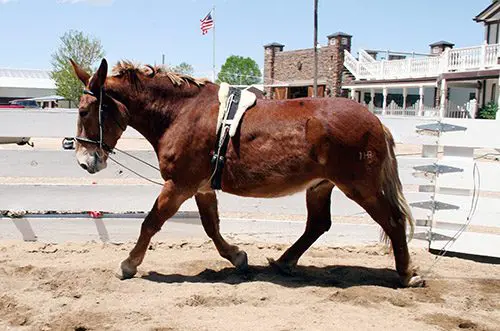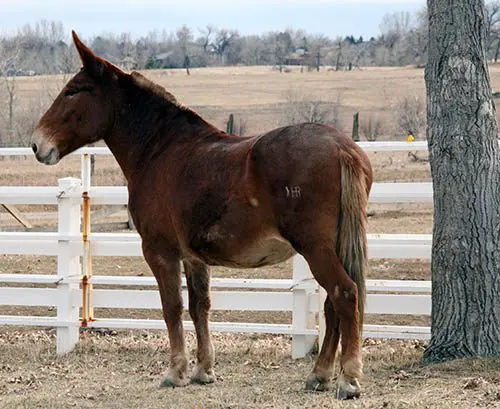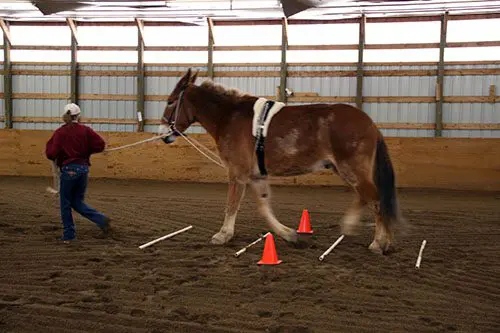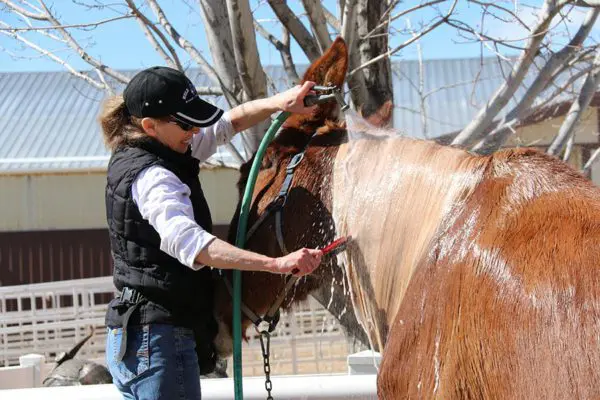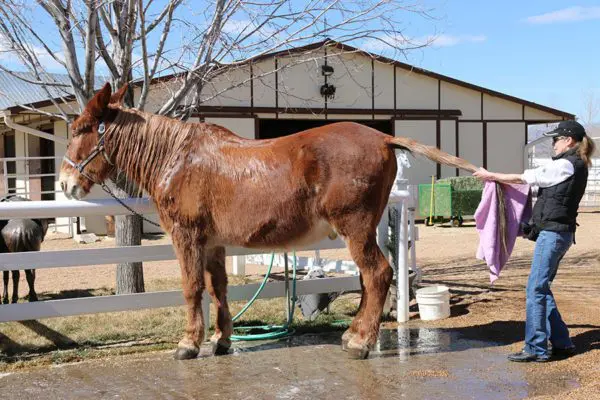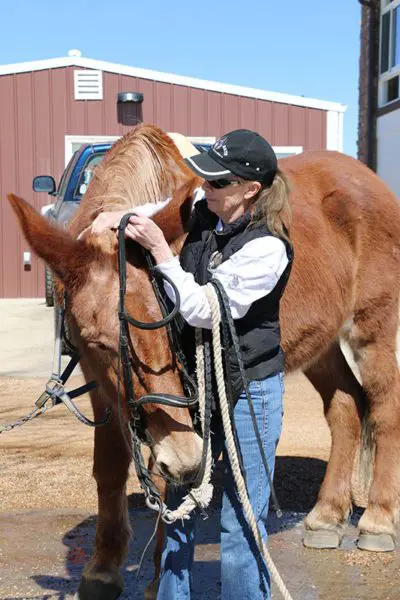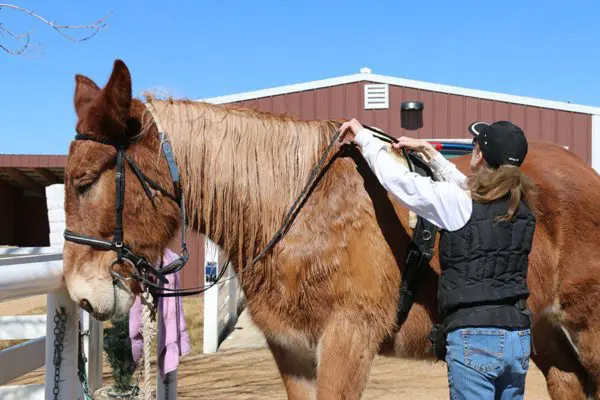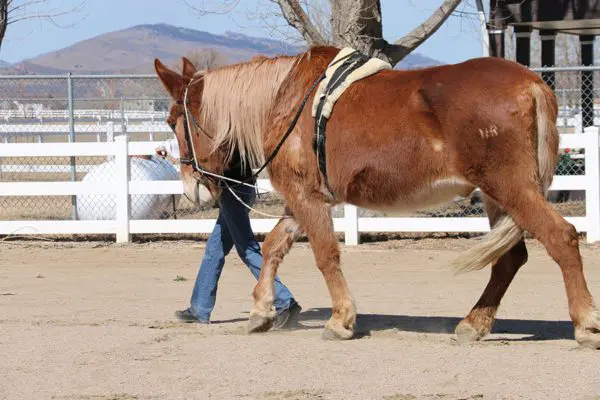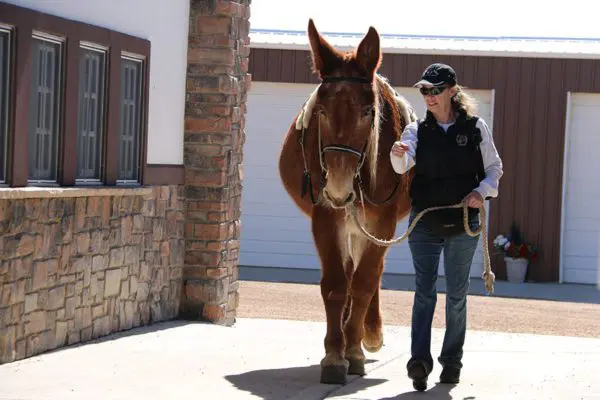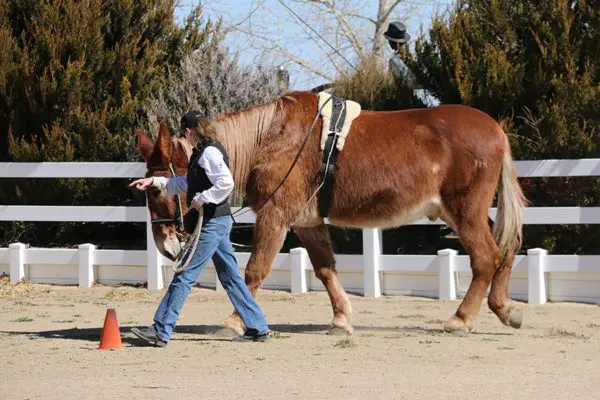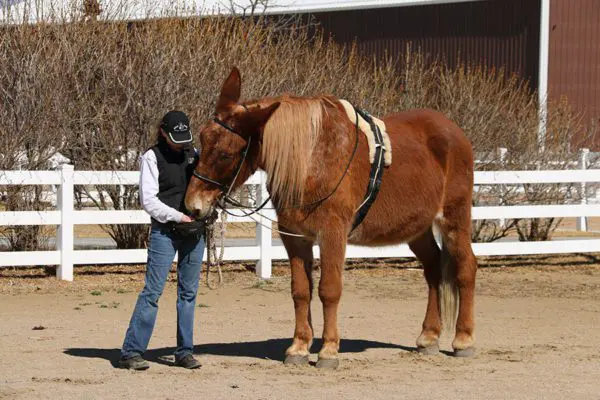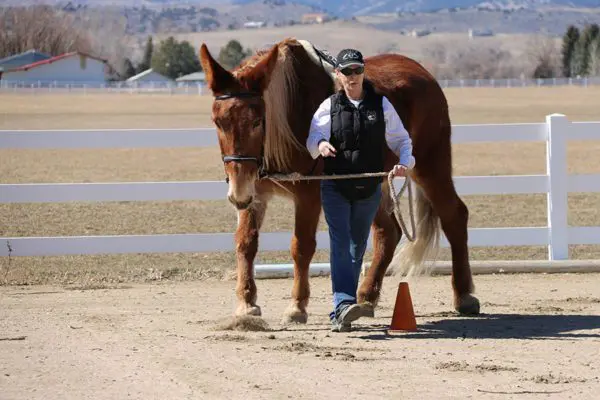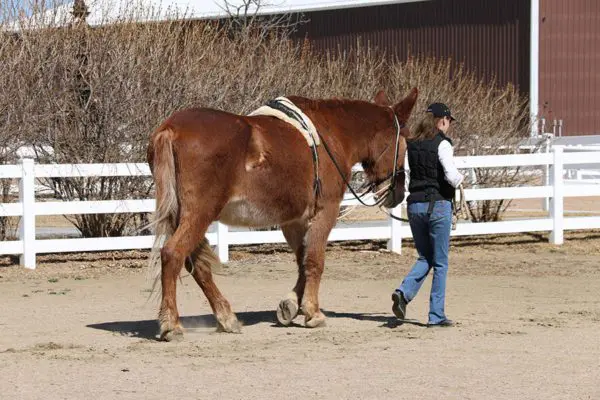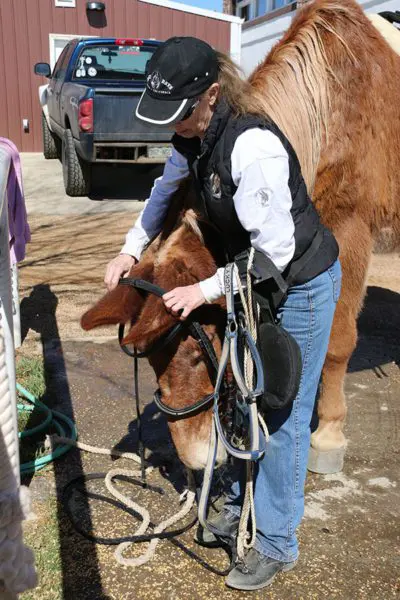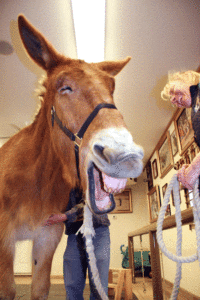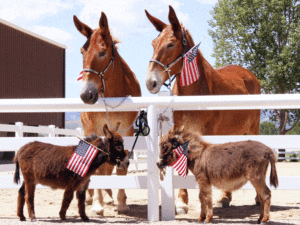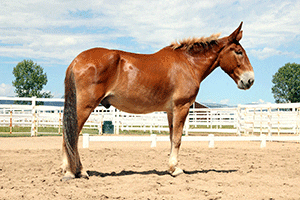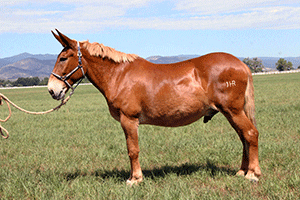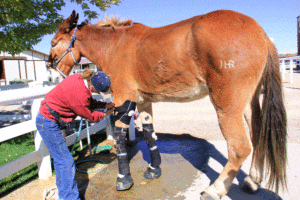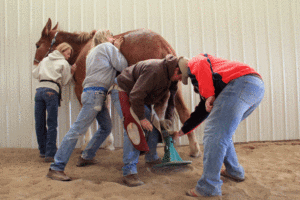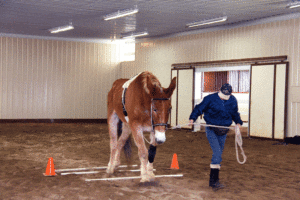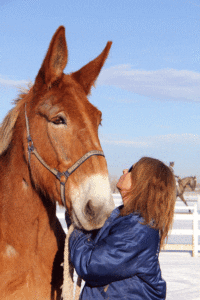By Meredith Hodges
In Part 1 of Rock and Roll: Diary of a Rescue, we learned about the discovery and rescue of Belgian draft mules, Rock and Roll, by Meredith Hodges and her team of experts. As the pair’s rehabilitation continues, the road to recovery gets tougher. But for every health setback, there is a personality breakthrough with these courageous and now-trusting gentle giants—and always a reason to hope.
 By May of 2011, both mules were beginning to bond well with me and I was able to separate them during workouts. I knew I would have to develop a strong bond with Roll in case Rock didn’t make it, and we all knew the odds were not in Rock’s favor. Being alone with me in the round pen helped Roll to concentrate on the tasks at hand. His way of going was markedly improving with each new lesson.
By May of 2011, both mules were beginning to bond well with me and I was able to separate them during workouts. I knew I would have to develop a strong bond with Roll in case Rock didn’t make it, and we all knew the odds were not in Rock’s favor. Being alone with me in the round pen helped Roll to concentrate on the tasks at hand. His way of going was markedly improving with each new lesson.
Both mules could now square up  properly and move in a much more balanced frame, although holding that balance was intermittent. The personality of each mule began to emerge and they became more willing to play games and to be touched and kissed about their heads. Rock was much more overt about his pleasure during the massages, and we could finally tell that they were beginning to trust us.
properly and move in a much more balanced frame, although holding that balance was intermittent. The personality of each mule began to emerge and they became more willing to play games and to be touched and kissed about their heads. Rock was much more overt about his pleasure during the massages, and we could finally tell that they were beginning to trust us.
By mid-June, we were able to take the pads off Rock’s back feet and reset the shoes without the pads. He had grown three-eighths of an inch of sole on both hind feet and the rotation began to improve in one back foot. Both mules were feeling much better and were actually engaging in play during turnout. Next, we discovered that due to the concussion to his rear feet from improper use during driving in the past, Roll had side bones in his right hind foot. This caused him to twist that foot as it grew out between trims, so we put shoes on his back feet as well.

Rock loved our newly acquired mini donkeys and, during turnout, he would stand by their pen for the better part of the day. Here they all are on the Fourth of July, 2011.

By that time, Rock and Roll both looked magnificent! Considering the extent of Rock’s past neglect and injuries, he had gained incredible muscle tone and balance. His eyes were bright and alert, his coat was shiny and his feet were much improved (although they still exhibited a hint of chronic founder).

Roll’s fat and lumpy body had changed dramatically. Now his body was more symmetrical and balanced, and he also sported a shiny coat and balanced feet. His eyes were alert and his appearance of laziness had completely vanished.
However, by the end of July, Rock once again began to lose muscle tone over his right hip and his front feet became very sore. We thought he and Roll may have been playing too hard, which could have caused Rock to injure himself again, so we separated them into adjoining pastures during daily turnout. At night they remained in their respective stalls and runs, side by side. Custom-made boots were ordered for Rock’s front feet to help alleviate the pressure, but unfortunately we had to wait until the first of November for delivery of the boots. By the time they arrived, they were of use for only about two weeks before the weather changed. The wet snow and mud became packed in the boots, causing Rock too much pain on the dropped soles of his feet.
 While Rock was on three weeks of rest during August, he developed swelling in his sheath. He was treated with an anti-inflammatory for two weeks, but the swelling didn’t go down. Since his front feet seemed better, I decided to resume his physical therapy. Although the structured movement helped the swelling go down, it migrated to the midline of his abdomen. After two weeks of hot packing the abdomen twice a day, the swelling finally disappeared. Because Rock was becoming stronger and getting up and down more often, he was beginning to develop sores on his knees, fetlocks and hocks, and “shoe boils” on his underbelly (pressure sores caused by his hooves when lying down), all of which needed to be frequently tended to.
While Rock was on three weeks of rest during August, he developed swelling in his sheath. He was treated with an anti-inflammatory for two weeks, but the swelling didn’t go down. Since his front feet seemed better, I decided to resume his physical therapy. Although the structured movement helped the swelling go down, it migrated to the midline of his abdomen. After two weeks of hot packing the abdomen twice a day, the swelling finally disappeared. Because Rock was becoming stronger and getting up and down more often, he was beginning to develop sores on his knees, fetlocks and hocks, and “shoe boils” on his underbelly (pressure sores caused by his hooves when lying down), all of which needed to be frequently tended to.
 In September, once again there was swelling on Rock’s underside midline, which also seemed to cause him to get weaker musculature in the hips. The swelling was hot-packed, and it disappeared fairly quickly this time. By mid-October, Rock was lying down for prolonged periods of time—unhealthy for an equine—so his support team of three veterinarians, two equine chiropractors, his equine masseuse and I got together to assess his condition. All 2000 plus pounds of his weight was being shifted off his three bad feet and onto his left hind leg, causing it to track behind the right front when he walked. We decided on a regimen of phenylbutazone (a non-steroidal anti-inflammatory drug), minimal exercise, plenty of rest and icing of his feet for 15-20 minutes twice daily. Things were not looking good.
In September, once again there was swelling on Rock’s underside midline, which also seemed to cause him to get weaker musculature in the hips. The swelling was hot-packed, and it disappeared fairly quickly this time. By mid-October, Rock was lying down for prolonged periods of time—unhealthy for an equine—so his support team of three veterinarians, two equine chiropractors, his equine masseuse and I got together to assess his condition. All 2000 plus pounds of his weight was being shifted off his three bad feet and onto his left hind leg, causing it to track behind the right front when he walked. We decided on a regimen of phenylbutazone (a non-steroidal anti-inflammatory drug), minimal exercise, plenty of rest and icing of his feet for 15-20 minutes twice daily. Things were not looking good.
No matter what was asked of him, Rock always gave it his all. We babied him through turnout, chiropractics, trims, and massage, but it finally got to the point where we could barely get his back feet off the ground to apply the hoof dressing. We decided to remove his shoes. That day, he was so weak in the hindquarters we could not replace them and couldn’t even trim the feet without running the risk of him falling down. We waited a couple of weeks before we trimmed his heels with the aid of a custom-made, six-inch equine jack stand. That seemed to help through November and part of December, but Rock still needed the Thrush Buster and Rainmaker for hoof health. He was able to tip his hind feet forward and let us have the bottoms of his feet for a few seconds at a time so the medication could be applied. Finally, he just couldn’t manage having his feet elevated at all—the pain was too great. Around this time, we noticed that the swelling had again cropped up in his midline abdomen, which led to another week of hot packing it twice a day.
 After Christmas, I decided to resume a modified version of his physical therapy. Trooper that he was, he tried with all his might, but his hips were listing terribly to the left, and the first time he went over the three one-inch ground poles, he crashed into every one of them. His third time over, he grazed just one. When I put him back in his pen, he immediately laid down. I then noticed the bulging in the coronet band of his left hind foot. He was “sinking!” We immediately called the vet and he confirmed my fear. The lamina was pulling away from the hoof wall and allowing the bones to “sink” through the sole of Rock’s hoof. It wouldn’t be long before the other feet would quickly follow suit. It was clear that he was in agony and would have to be put down, so our vet came out the ranch, loaded Rock up with anti-inflammatory and pain medications and said he would be back the next afternoon.
After Christmas, I decided to resume a modified version of his physical therapy. Trooper that he was, he tried with all his might, but his hips were listing terribly to the left, and the first time he went over the three one-inch ground poles, he crashed into every one of them. His third time over, he grazed just one. When I put him back in his pen, he immediately laid down. I then noticed the bulging in the coronet band of his left hind foot. He was “sinking!” We immediately called the vet and he confirmed my fear. The lamina was pulling away from the hoof wall and allowing the bones to “sink” through the sole of Rock’s hoof. It wouldn’t be long before the other feet would quickly follow suit. It was clear that he was in agony and would have to be put down, so our vet came out the ranch, loaded Rock up with anti-inflammatory and pain medications and said he would be back the next afternoon.
Every day for a year, I prayed for a miracle for Rock and each time I prayed, he got better. I now wondered if God would give us yet another miracle and let him live—but it wasn’t meant to be. On December 27th, 2011, surrounded by his Lucky Three family, our beautiful Rock took his last steps. We all knew it was time for us to let him go. Rock was euthanized at home and died peacefully, with his head resting in my hands.
My vet Greg Farrand informed me that the president of Colorado State University had pulled together a team for Rock’s necropsy and the preservation of his skeleton as a teaching aid for the CSU Veterinary Sciences department.
When the necropsy came back, it showed not a single fracture of Rock’s pelvis, but rather multiple old fractures in the socket of the hip joint. The bottom of the socket was almost completely gone and there was a hole the size of a dime at the top of the socket. The head of the femur had no cartilage left and there was fibrosis and cysts full of fluid the entire length of the femur stem.
I have come to realize that our courageous and noble Rock gave us more than one miracle. He had been able to live one more year of life with a severely shattered hip joint and compromised femur. He proved that our balance and core muscle therapy can work wonders! And he lived long enough to give his half-brother, Roll, the chance to bond with people who will love and care for him for the rest of his life. Thank you and God bless you, Rock. We will miss you.

To learn more about Meredith Hodges and her comprehensive all-breed equine training program, visit LuckyThreeRanch.com, MEREDITH HODGES PUBLIC FIGURE Facebook page, or call 1-800-816-7566. Check out her children’s website at JasperTheMule.com. Also, find Meredith on Pinterest, Instagram, MeWe, YouTube and Twitter.
Covered in TRAINING MULES & DONKEY: A LOGICAL APPROACH TO TRAINING, TRAINING WITHOUT RESISTANCE, EQUUS REVISITED and A GUIDE TO RAISING & SHOWING MULES, ROCK & ROLL: DIARY OF A RESCUE 2-PT DOCUMENTARY (VOD & DVD) at www.luckythreeranchstore.com.
© 2012, 2016, 2020, 2024 Lucky Three Ranch, Inc. All Rights Reserved.




 Horse trainers have kept us in awe of their unique and significant talents for centuries, and now that their techniques are more public, many equine professionals will pooh-pooh those who attempt a “kinder” approach to training. Scientists who study the equine in motion—its nutrition, biomechanics, care and maintenance—have their own perceptions to offer as to what we can learn about equines. Because many of these studies and tests are done in the laboratory, scientists rarely have the opportunity to follow their subjects throughout a lifetime of activity, as well as having the opportunity to experience what it really means for you as a rider, to be in balance with your equine when you work together, whether you are leading, lunging, riding or driving. If they did, their findings would probably yield quite different results. With all this progressive scientific thought, it seems to me that common sense can often get lost in the shuffle and respect for the living creature’s physical, mental and emotional needs may not be met.
Horse trainers have kept us in awe of their unique and significant talents for centuries, and now that their techniques are more public, many equine professionals will pooh-pooh those who attempt a “kinder” approach to training. Scientists who study the equine in motion—its nutrition, biomechanics, care and maintenance—have their own perceptions to offer as to what we can learn about equines. Because many of these studies and tests are done in the laboratory, scientists rarely have the opportunity to follow their subjects throughout a lifetime of activity, as well as having the opportunity to experience what it really means for you as a rider, to be in balance with your equine when you work together, whether you are leading, lunging, riding or driving. If they did, their findings would probably yield quite different results. With all this progressive scientific thought, it seems to me that common sense can often get lost in the shuffle and respect for the living creature’s physical, mental and emotional needs may not be met. degenerative breakdown. For instance, those who get in a hurry in Dressage and do not take a full year at each level in order to develop their equine’s body slowly and methodically may discover, several years later, that their animal has developed ringbone, side bones, arthritis or some other internal malady. These types of injuries and malformations are often not outwardly exhibited until it is too late to do anything about them.
degenerative breakdown. For instance, those who get in a hurry in Dressage and do not take a full year at each level in order to develop their equine’s body slowly and methodically may discover, several years later, that their animal has developed ringbone, side bones, arthritis or some other internal malady. These types of injuries and malformations are often not outwardly exhibited until it is too late to do anything about them.

 Tragically, many equines are suffering from abuse every day, while they are trying to please their owners and do what is asked of them. Their owners and trainers take shortcuts that compromise the equine’s health. It could be that these owners and trainers are trying to make choices with limited knowledge and really don’t know whom to believe. But ignorance is not a valid defense and sadly, the animal is the one that ends up suffering.
Tragically, many equines are suffering from abuse every day, while they are trying to please their owners and do what is asked of them. Their owners and trainers take shortcuts that compromise the equine’s health. It could be that these owners and trainers are trying to make choices with limited knowledge and really don’t know whom to believe. But ignorance is not a valid defense and sadly, the animal is the one that ends up suffering. The Lucky Three mules have always been worked in good posture, and spend only as much time on the hot walker as it takes for them to dry after a bath. They maintain their good posture while walking and rarely let the hot walker “pull” them into bad posture.
The Lucky Three mules have always been worked in good posture, and spend only as much time on the hot walker as it takes for them to dry after a bath. They maintain their good posture while walking and rarely let the hot walker “pull” them into bad posture. Like many, I am of the belief that mechanical devices that force an equine into a rounded position do not necessarily put that equine in good posture. I would guess that many trainers think the “Elbow Pull” device that I use is guilty of developing this artificial posture. If that is their opinion, then they do not understand how it works. Rather than pulling the equine’s head down into a submissive position, when adjusted correctly, the “Elbow Pull” acts like a balance bar (like a ballet dancer would use) to help the equine to balance in good posture. It takes time to develop good posture. So, in the beginning, your equine can only sustain good posture for a certain number of measured steps, and then he must “lean” on the “Elbow Pull” in between these moments of sustaining his ideal balance on his own. The “Elbow Pull” simply prevents him from raising his head and neck so high that the neck becomes inverted and the back hollowed, but it does not actually pull his head down. The rope itself is very lightweight and puts virtually no weight on his head and neck at all. Note: Because horses react differently than mules and donkeys when hard-tied, a simple adjustment to allow the “Elbow Pull” to “slip” with a horse is necessary.
Like many, I am of the belief that mechanical devices that force an equine into a rounded position do not necessarily put that equine in good posture. I would guess that many trainers think the “Elbow Pull” device that I use is guilty of developing this artificial posture. If that is their opinion, then they do not understand how it works. Rather than pulling the equine’s head down into a submissive position, when adjusted correctly, the “Elbow Pull” acts like a balance bar (like a ballet dancer would use) to help the equine to balance in good posture. It takes time to develop good posture. So, in the beginning, your equine can only sustain good posture for a certain number of measured steps, and then he must “lean” on the “Elbow Pull” in between these moments of sustaining his ideal balance on his own. The “Elbow Pull” simply prevents him from raising his head and neck so high that the neck becomes inverted and the back hollowed, but it does not actually pull his head down. The rope itself is very lightweight and puts virtually no weight on his head and neck at all. Note: Because horses react differently than mules and donkeys when hard-tied, a simple adjustment to allow the “Elbow Pull” to “slip” with a horse is necessary.

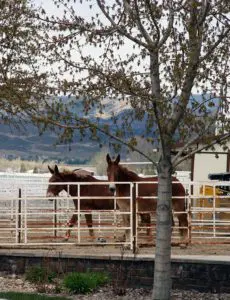 Before most of us learn anything about horses, mules and donkeys, we tend to initially perceive them as large, strong and durable animals that can safely carry us anywhere we want to go and can participate in any number of equine events. This is essentially true. However, there can be a number of pitfalls along the way if you do not educate yourself and practice good maintenance, feeding and training practices.
Before most of us learn anything about horses, mules and donkeys, we tend to initially perceive them as large, strong and durable animals that can safely carry us anywhere we want to go and can participate in any number of equine events. This is essentially true. However, there can be a number of pitfalls along the way if you do not educate yourself and practice good maintenance, feeding and training practices. Let’s take this one step at a time. First, make sure that your equine is stabled in a place where he has adequate shelter from the elements, plenty of room to exercise himself when you are not there, clean water and a good feeding schedule. When an equine is nervous or high strung, it can usually be attributed to this very elemental beginning. Many show horses are kept in 12-foot by 12-foot stalls with limited turnout during the day, usually only an hour or two. Think about this for a minute. The equine is a grazing animal and his natural health is enhanced by what he eats and the fact that he is moving with his head down most of every day of his life. The only time his head is truly raised is when he is on alert.
Let’s take this one step at a time. First, make sure that your equine is stabled in a place where he has adequate shelter from the elements, plenty of room to exercise himself when you are not there, clean water and a good feeding schedule. When an equine is nervous or high strung, it can usually be attributed to this very elemental beginning. Many show horses are kept in 12-foot by 12-foot stalls with limited turnout during the day, usually only an hour or two. Think about this for a minute. The equine is a grazing animal and his natural health is enhanced by what he eats and the fact that he is moving with his head down most of every day of his life. The only time his head is truly raised is when he is on alert. Muscles in the equine’s body, like our own, are structured in distinctive layers and are supported by ligaments and tendons. These muscles need to be strengthened in a specific order for optimum performance. Whether he is a foal or an older animal, his athletic conditioning needs this taken into consideration. The first exercises should be passive and easy to facilitate the strengthening of the core muscles closest to the bone. This is done with exercises on the lead line. It is not as important that he learns to negotiate obstacles on the lead line as it is how he negotiates the obstacles on the lead line.
Muscles in the equine’s body, like our own, are structured in distinctive layers and are supported by ligaments and tendons. These muscles need to be strengthened in a specific order for optimum performance. Whether he is a foal or an older animal, his athletic conditioning needs this taken into consideration. The first exercises should be passive and easy to facilitate the strengthening of the core muscles closest to the bone. This is done with exercises on the lead line. It is not as important that he learns to negotiate obstacles on the lead line as it is how he negotiates the obstacles on the lead line. For instance, when approaching a bridge, walk with your equine’s head at your shoulder as if you were in a showmanship class. Stop at the foot of the bridge and encourage your equine to stretch his nose down and investigate the bridge in order to allay any fears he might have. When your animal has indicated he is not afraid by once again raising his head level with his withers, you can proceed. Face the bridge straight on, looking straight ahead and, while keeping his head at your shoulder, take the first step straight forward and onto the bridge, making sure he follows and places one front foot on the bridge itself. Next, ask him to place the other front foot onto the bridge, stop, square up his four feet (as in Showmanship) and reward. Continue forward in a straight line. Once all four of his feet are on the bridge, stop, square up and give him a reward. Then continue across the bridge maintaining your own good posture, hesitate at the last step, and then step off carefully, in good balance and with a coordinated effort. Ask him to place his two front feet on the ground while leaving the back feet on the bridge, stop, square up and reward. Your equine will learn to follow your lead and execute the task in the same balanced and coordinated manner and will be able to halt on command at any location.
For instance, when approaching a bridge, walk with your equine’s head at your shoulder as if you were in a showmanship class. Stop at the foot of the bridge and encourage your equine to stretch his nose down and investigate the bridge in order to allay any fears he might have. When your animal has indicated he is not afraid by once again raising his head level with his withers, you can proceed. Face the bridge straight on, looking straight ahead and, while keeping his head at your shoulder, take the first step straight forward and onto the bridge, making sure he follows and places one front foot on the bridge itself. Next, ask him to place the other front foot onto the bridge, stop, square up his four feet (as in Showmanship) and reward. Continue forward in a straight line. Once all four of his feet are on the bridge, stop, square up and give him a reward. Then continue across the bridge maintaining your own good posture, hesitate at the last step, and then step off carefully, in good balance and with a coordinated effort. Ask him to place his two front feet on the ground while leaving the back feet on the bridge, stop, square up and reward. Your equine will learn to follow your lead and execute the task in the same balanced and coordinated manner and will be able to halt on command at any location. Halters that are too loose allow too much lag time between the time you ask by giving a tug and the time the equine receives the message. This usually results in an over-reaction from your equine and then an over-reaction from you as you try to correct the mistake. A halter that is too tight can be a distraction because it can create sore spots—the equivalent to a headache and no one likes to perform with a headache! The lead line typically should be a length that you can easily handle and that will give your equine some room to move away, but that can be reorganized easily, usually about six to eight feet long.
Halters that are too loose allow too much lag time between the time you ask by giving a tug and the time the equine receives the message. This usually results in an over-reaction from your equine and then an over-reaction from you as you try to correct the mistake. A halter that is too tight can be a distraction because it can create sore spots—the equivalent to a headache and no one likes to perform with a headache! The lead line typically should be a length that you can easily handle and that will give your equine some room to move away, but that can be reorganized easily, usually about six to eight feet long. This is when it can be beneficial to know the basics of equine massage therapy. There is a lot that you, as your equine’s trainer, can do without a professional equine masseuse, but you should always consult with a professional for lessons on how you can do your part. Make sure that the equine masseuse you decide to use is a person who knows equines and has at least 500 hours experience with equine massage therapy. Once you learn some massage techniques, you can often alleviate minor soreness exhibited by your equine. When your equine senses that your goal is to make him comfortable as well as successful in his work, he will be much more willing and able to comply.
This is when it can be beneficial to know the basics of equine massage therapy. There is a lot that you, as your equine’s trainer, can do without a professional equine masseuse, but you should always consult with a professional for lessons on how you can do your part. Make sure that the equine masseuse you decide to use is a person who knows equines and has at least 500 hours experience with equine massage therapy. Once you learn some massage techniques, you can often alleviate minor soreness exhibited by your equine. When your equine senses that your goal is to make him comfortable as well as successful in his work, he will be much more willing and able to comply.
